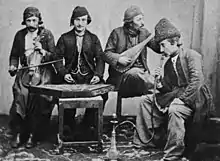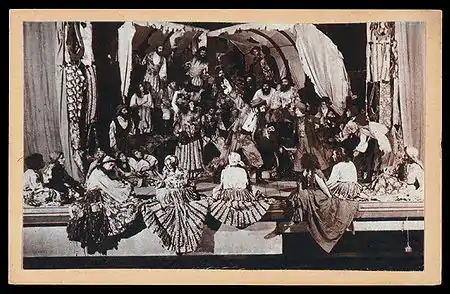Ruska Roma
The Ruska Roma (Russian: Руска́ Рома́), also known as Russian Gypsies (Russian: Русские цыгане) or Xaladitka Roma (Russian: Халадытка Рома, romanized: Khaladytka Roma, i.e. "Roma-Soldiers"),[2] are the largest subgroup of Romani people in Russia and Belarus.[3] Initially known as Ruska Roma, they live mostly in Russia and Belarus, but also in Eastern and Central Ukraine, the United States, France, and Canada.
| Total population | |
|---|---|
| 209,000[1] | |
| Languages | |
| Russian[1] | |
| Religion | |
| Christianity[1] |

The Ruska Romani language contains some Russian, Polish, and German words, as well as a small amount of Russian and Ukrainian grammar. Most Ruska Roma are Orthodox Christians, while those living in predominantly Muslim areas (such as the Caucasus) tend to be Muslim.[3]
Ruska Roma in Russian history


Judging by the language of Russian Roma, their ancestors spent some time in Germany and Poland before coming to the East Slavic territories. The existing sources start mentioning Roma population on the territory of Russia since the beginning of the 18th century. For instance, the Scottish traveler John Bell writes about Roma people coming from Poland, sent away from the Tobolsk region in 1721.
Soon after their arrival in Russia, ancestors of Russian Roma became involved in entertainment, playing and singing at large celebrations. Since the 19th century, Russian Roma living in large cities such as Moscow and Saint Petersburg started creating Romani choirs, which soon became very popular among the Russian urban population. Nomadic Russian Roma were engaged in horse dealing and fortune telling.
A drastic change in the life of nomadic Russian Roma took place in 1956 when a special decree issued by the Soviet government banned Roma from leading a nomadic life. Russian Roma had to start living in houses permanently, although they are still more mobile than non-Roma population and can easily change their place of residence. Nowadays Russian Roma often live dispersed, but they do tend to look for a house or flat in the area where other Roma are also present. Russian Roma prefer to live in private houses, but it is not uncommon for a Russian Romani family to live in a flat.
Russian Roma are also one of the most educated Romani groups in Russia. Many Russian Roma work as lawyers, doctors and teachers. The number of Russian Roma receiving university-level education is constantly growing.
Although Russian Roma still prefer to marry within the Romani community, cases of mixed marriages with non-Romani partners are quite numerous.
Notable Ruska Roma
- Nikolai Shishkin, Russian theatre personality
- Valentina Ponomaryova, theatre actors
Fictional characters
- Jardani Jovonovich, fictional birthname of the John Wick character named specifically in the third film John Wick: Chapter 3 – Parabellum.
See also
References
- Project, Joshua. "Romani, Ruska Roma in Russia". joshuaproject.net.
-
"Roma and 'Gypsies'". Retrieved 2016-02-11.
Ruska Roma [...] Also called 'Xaladitka Roma' (Gypsy soldiers), are the most numerous group in Russia. These are probably the first Roma who settled in that land, likely coming from the Caucasus, and they speak an Old Romany language. They are widespread throughout Russia even up to the Kamchatka Peninsula and across the boundaries with China, as well as in Ukraine, and some of them live beyond the western border, in Poland. The Ruska Roma are an endogamic group which keeps the Romany Law.
- "Nomadic people. N.Bessonov. National Geographic Russia, April 2007". Archived from the original on 2007-04-28.